ASRock Vision 3D Review
ASRock Vision 3D
Small, stylish, stuffed full of features, connectivity and high-end yet frugal components; the home theatre PC to rule them all has arrived.
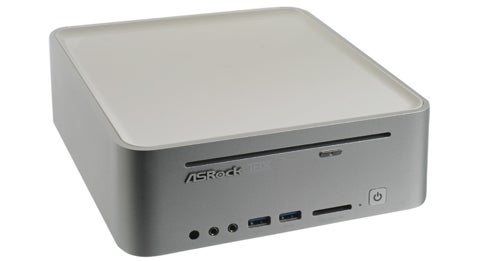
Verdict
Key Specifications
- Review Price: £660.00
ASRock’s previous home theatre PC (HTPC), the Core 100HT-BD, was one of the best multimedia desktop systems we had ever reviewed. Indeed, it richly deserved its second place in our 2010 Awards. If we had any complaints, it was that the Core wasn’t exactly the most attractive box to stick in with your AV gear and that it didn’t do 3D, which is becoming ever more prevalent in the home entertainment market. Enter ASRock’s new Vision 3D, which fixes these issues and more besides.
The appropriately-named Vision certainly is something to behold. Clad mostly in seamless anodized aluminium, with smooth, curved corners and a slot-loading Blu-ray drive, it’s easily up there with the Acer Aspire Revo 100 and Zotac ZBOX in the design stakes, but far surpasses them in build quality. In fact, it’s almost playing in Apple’s court, and most closely resembles an older, taller Apple Mac Mini. It’s available in two colour combinations: a lacquered white plastic top and unpainted aluminium, like our review sample, or an all-black version which will fit in better with most people’s AV setup. Either way, it’s one attractive little machine.
It might be bigger than a Mac Mini, but it’s also considerably better in almost every way. Aside from being the world’s first 3D HTPC (it’s been out a little while), it offers every connection you could ever need, and its internals are nothing to sniff at. 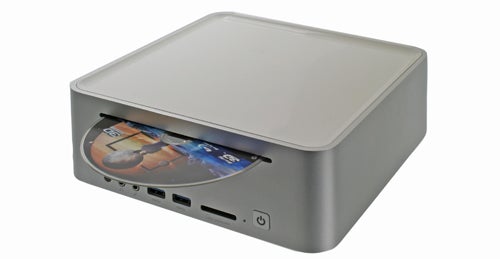
Heading the cast is an Intel Core i3 370M. As you might have guessed, the M indicates it’s essentially a mobile CPU, meaning it will use far less power than desktop equivalents. However, it should still have more than enough grunt for the vast majority of what you might throw at it. Unlike its desktop namesakes, this dual-core Core i3 supports HyperThreading for up to four virtual cores, and hums along at 2.4GHz.
It’s backed up by 4GB of 1066MHz DDR3 RAM, which is about what you would expect on a high-end HTPC. It’s not expandable without chucking the 2GB DIMMs, but you shouldn’t need to upgrade this in the machine’s useful lifetime. Meanwhile, permanent storage is generously taken care of by a 500GB 2.5in/’laptop’ drive, which runs at a speedy 7,200rpm. 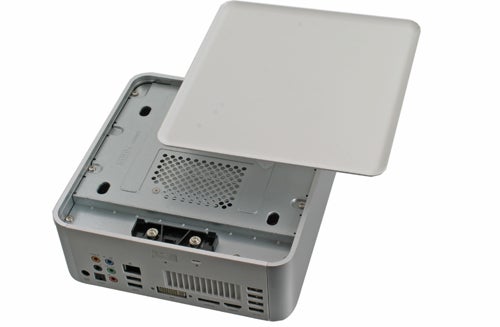
The real highlight here though is Nvidia’s GT 425M mobile graphics chip. Again it’s a low power, low heat mobile part, but should be capable enough for some halfway decent gaming and, more importantly, can output 3D to a compatible screen or television with stereoscopic glasses. This, of course, is where the ASRock gets the 3D Vision part of its name from. Naturally a Blu-ray drive and CyberLink’s 3D-compatible PowerDVD 10 are also on hand to let you watch those third-dimensional Blu-ray discs (all five of them, but this will increase dramatically in 2011).
Though you can buy models that are ready to go out of the box from certain retailers, ASRock supplies the Vision 3D without an operating system, so you’ll most likely need to install your own. To support all the machine’s features, Windows 7 64-bit is the obvious choice, and indeed ASRock provides a driver disc for just this OS.
The disc is quite well presented, though we wish there was just a single option to install all of the drivers in one go, rather than being forced to install each one separately. Of course, if you have access to the internet, it’s best to just download the most recent ones from relevant websites. Overall, the entire installation process is very simple and shouldn’t take you more than an hour at most. 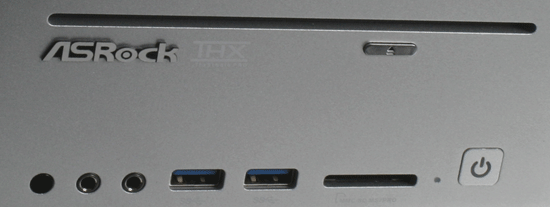
Connectivity is also sublime. At the front, unobtrusive cut-outs in the thick aluminium surround reveal an IR sensor, 3.5mm headphone and microphone jacks, two USB 3.0 ports and a card reader (that takes MMC, SD/HC and MS/Pro), alongside the tiny orange hard drive activity LED and blue-backlit power button.
Around the back, you’ll find a third USB 3.0 port, addressing one of our main issues with the Core 100HT-BD (though we would still have preferred two of these at the back and one at the front, rather than the other way around) and another five USB 2.0 ports. eSATA II is also on hand, giving equally fast data connectivity for older SATA 3Gb/s devices and exceeding USB 3.0’s transfer speeds with true 6Gb/s drives. Gigabit Ethernet and Wi-Fi N take care of wired and wireless networking respectively. 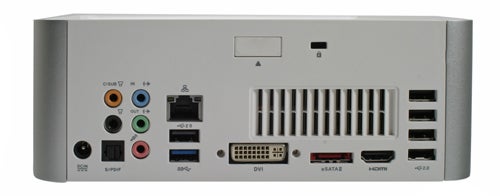
Where video is concerned you’ll find both DVI and HDMI, the latter being version 1.4 for full 3D and audio return channel compatibility. On the audio side of things, if not using HDMI (which supports HDMI Bitstream for Dolby TrueHD and DTS HD Master audio) there is digital optical, and 7.1 analogue – both enhanced by THX TruStudio Pro processing.
That’s pretty much every connectivity option we could want on a PC. Bluetooth is the only absentee you might still wish for, but that’s easily added with a £5 miniature USB dongle. There’s also no TV tuner, but in the unlikely case your TV doesn’t have one or you’re using this with a monitor, again it can be added through USB (unlike the Tranquil PC iXL there’s no expansion card bracket for installing one internally). 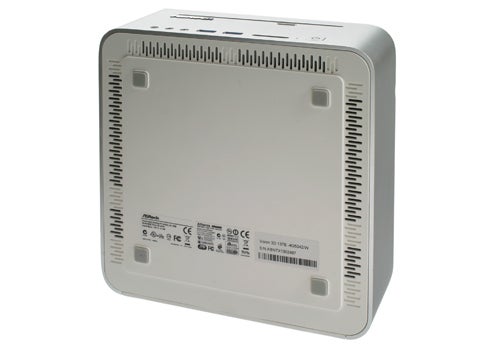
Accessories include a DVI-VGA adapter and SATA power plus data cables. The Windows Media remote is a very different beast to before, and although it’s now slimmer and more stylish, we’re not overly enthusiastic about the change. This slim remote requires cell batteries, so you can’t use rechargeable ones like before. Its buttons are smaller, more difficult to press and crowded together, and it doesn’t lie as comfortably in the hand. Still, it’s far from unusable and can easily be replaced with something better.
Unlike the Acer Aspire Revo 100, ASRock’s Vision 3D uses a full-fat processor, and it shows. The Vision 3D’s 2.4GHz Core i3 370M comfortably outperforms most similarly-sized HTPCs: it simply obliterates the Zotac ZBOX (Intel Atom) and Revo 100 (AMD Neo), and even stays a fair margin ahead of ASRock’s previous Core 100HT-BD, which used an older, 2.13GHz Core i3. The only recently-reviewed machine of a similar size that beats it is the Tranquil PC iXL, thanks to a 3GHz Core i3.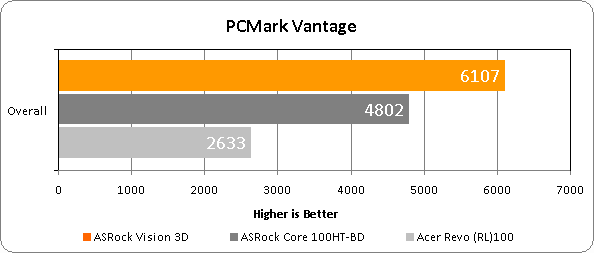
Regardless of Nvidia’s marketing claims to the contrary, its GT425M mobile graphics card is not adequate for gaming enthusiasts, and won’t let you play many titles in stereoscopic 3D. However, it’s certainly a lot more competent than the solutions used in most HTPCs. We threw Stalker:COP at it on full blast, a test we usually reserve for gaming PCs, and the Vision 3D still managed an almost playable 22 frames per second (fps). Lowering detail and resolution achieved a perfectly playable 36.7fps average.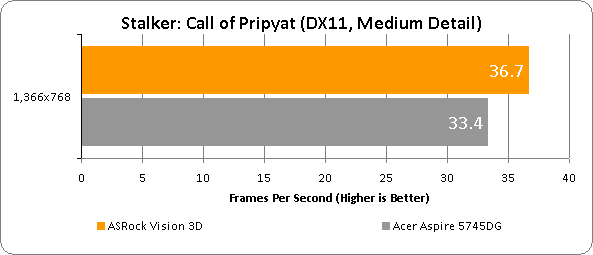
Unsurprisingly, the ASRock performs very similarly to Acer’s Aspire 5745DG here, as both machines sport identical processors, graphics cards and amounts of RAM. As with that Nvidia 3D laptop, If you did want to try stereoscopic gaming, undemanding titles like TrackMania are still the way to go.
Intensive games aside though, the ASRock Vision 3D will handle anything you can reasonably demand from an HTPC – and do so without excessive noise pollution, getting too hot or weighing in too heavily on your electricity bill. Even under load, the machine never became more than lukewarm to the touch, and its soft fan-whir puts it among the most silent systems we’ve tested (though nothing beats the passively-cooled iXL in this regard). 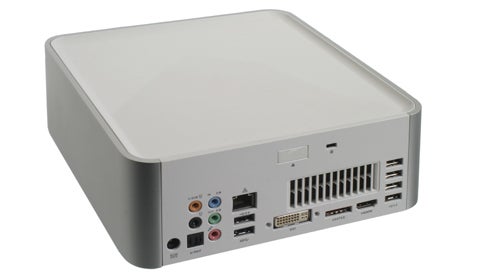
Thanks to the exclusive use of mobile parts, it’s also very energy efficient. ASrock claims the Vision 3D will use under 60W even under the heaviest loads, and shouldn’t go far over 40W during Blu-ray playback. Indeed, 40W was the most we could get it to use during gaming or under a normal load. Think about it: even when you’re playing games or watching 3D films, this PC uses no more electricity than an average incandescent light bulb!
It’s when it comes to value that this HTPC hits its first significant snag. The reviewed configuration with a Blu-ray drive demands £660, or it can be found with a DVD-Rewriter for £605. Throw in a copy of Windows 7 Home Premium with the former, and you’re looking at well over £700. Suddenly, the £500 Aspire Revo 100 is starting to look like a bargain. 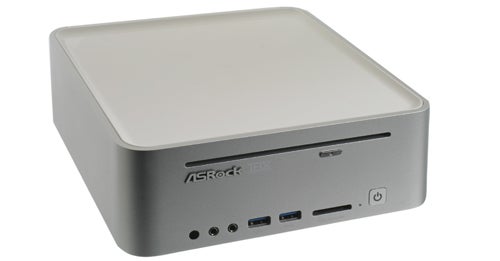
Of course you do get a lot more for your money with the ASRock Vision 3D: far superior build quality and more premium looks; slightly quieter operation; better upgradeability, expandability and far more connectivity; and a generally more powerful machine which can run undemanding games. It’s actually decent value for what it provides. However, for many the Revo will be powerful and fully-featured enough, and includes that sweet touchpad/touch-keyboard remote…
Verdict
ASRock’s Vision 3D home theatre PC is undoubtedly impressive. It’s compact, well-built, and offers every connection you could ever need. It’s powerful enough for most tasks, including light 3D gaming, while a mostly aluminium shell and slot-loading Blu-ray drive give it that premium touch. In fact, as an overall package it’s probably the most desirable HTPC we’ve seen so far.
However, you do pay for these luxuries, and there are cheaper alternatives that will perform similarly in core tasks like Full HD video and 3D Blu-ray playback.
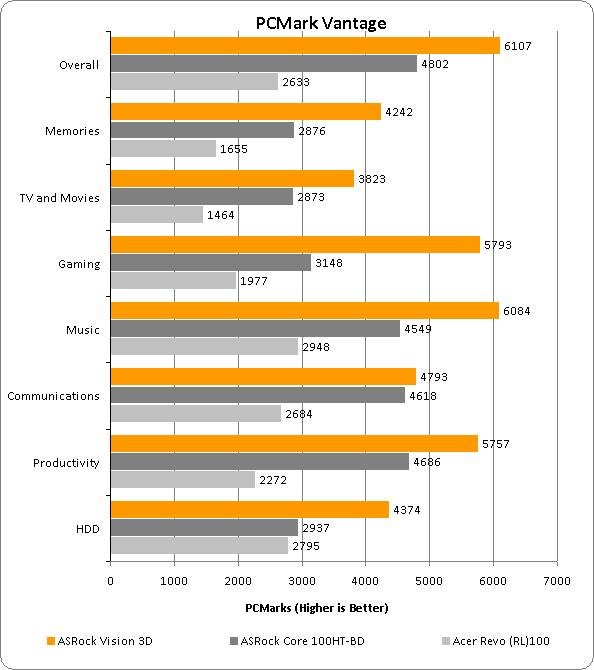
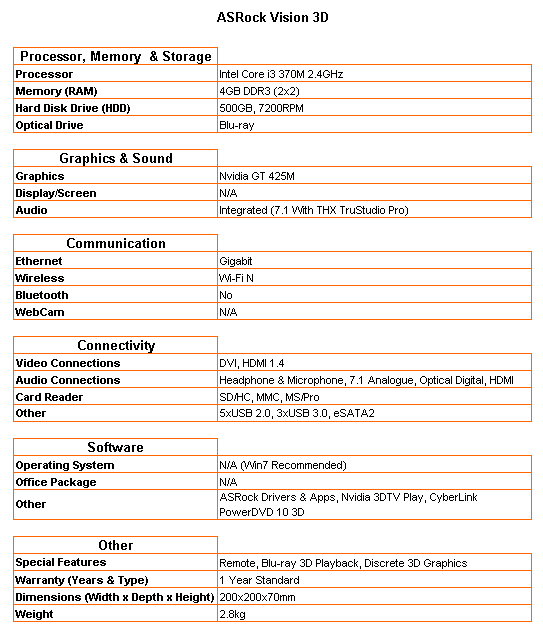
Trusted Score
Score in detail
-
Value 7
-
Features 9
-
Performance 8
-
Design 9

